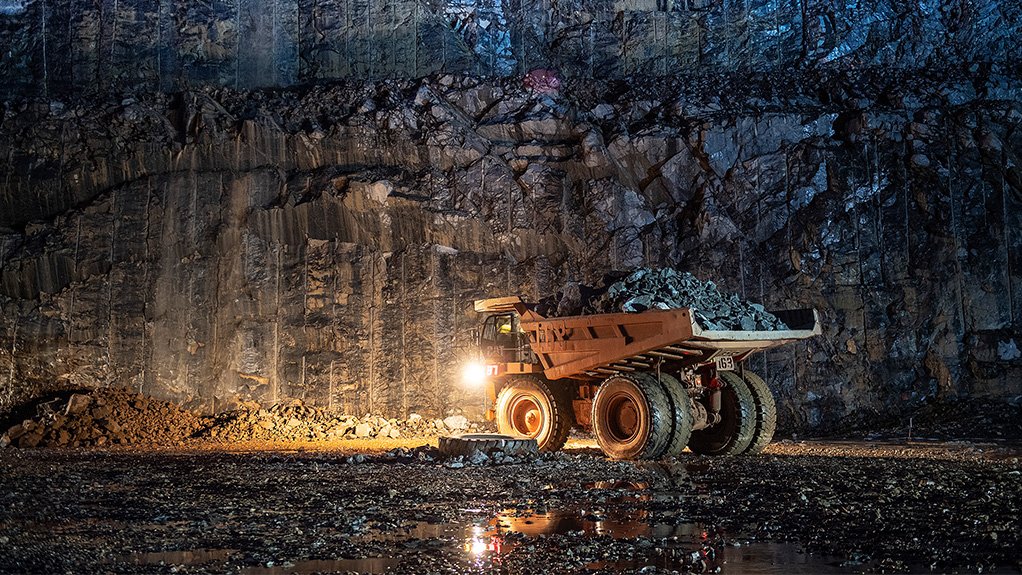Gold Fields posts higher full-year earnings, maintains dividend at R7.45
JSE- and NYSE-listed Gold Fields has declared a total dividend of R7.45 a share for the year ended December 31, with $703-million in attributable profit having been generated.
The attributable profit amounts to $0.79 apiece, compared with profit of $711-million, or $0.80 apiece, in the prior year.
Gold Fields generated $900-million in normalised earnings and reported 2.24-million ounces of group attributable production. The company was a few ounces short of its guided production range of 2.25-million to 2.3-million ounces.
This compares with normalised earnings of $860-million in the prior year.
The group achieved better all-in sustaining costs (AISC) of $1 295/oz compared with guidance of between $1 300/oz and $1 340/oz, as weaker exchange rates provided some reprieve to the inflationary pressures experienced in the year.
CEO Mike Fraser elaborates that the favourable Australian dollar and South African rand exchange rate, as well as a strong average gold price of $1 942/oz in the year under review, provided notable tailwinds for Gold Fields’ financial performance.
The company was able to generate $1-billion of free cash flow in the reporting period, compared with $855-million of free cash flow in the prior year, which allowed the company to declare the same total dividend as in 2022.
Adjusted free cash flow amounted to $367-million, less net capital expenditure, environmental payments, lease payments and the redemption of Asanko preference shares.
The dividend is equal to 40.1% of normalised earnings, in line with its policy of paying between 30% and 45% of normalised earnings in dividends.
Gold Fields recorded a $320-million increase in net debt in the reporting year, ending the year at $1.02-billion, with a net debt to adjusted earnings ratio of 0.42. Excluding lease liabilities, the core net debt stood at $588-million at year-end.
Fraser warns that the gold price and exchange rate tailwinds may not persist this year and that the favourable pricing cycle for the industry could turn; therefore, Gold Fields is committed to continue building a resilient business that delivers competitive returns to shareholders through price cycles.
“A key overlay to our strategy is the disciplined allocation of capital. As a priority, we invest in our existing operations to ensure safe and reliable production, while maintaining an investment grade credit rating,” Fraser states.
PRODUCTION EXPECTATIONS
Gold Fields’ production base is set to increase by 20% over the next two years as Salares Norte, in Chile, ramps up and the South Deep mine, in South Africa, builds up to 380 000 oz/y of production by the second half of 2026.
In the year under review, South Deep experienced a shortage of key skills, particularly for the long-hole stoping drill rig operations, which resulted in lower production of 322 000 oz, compared with 328 000 oz in the prior year.
Encouragingly, South Deep’s adjusted free cash flow increased by 78% year-on-year to R3.8-billion, which marks the fifth consecutive year of positive free cash flow from the mine.
The company’s production base is currently underpinned by its Australian assets, which are expected to continue producing about one-million ounces a year for at least the next decade.
Gold Fields expects to be mining deeper at these assets and to deliver on life extension opportunities.
In the year under review, the Australian mines produced 1.06-million ounces of gold, generating $486-million in adjusted free cash flow.
Gold Fields says the Gruyere mine was impacted on by the failure to achieve planned capital and waste material movements in the year, while the tight labour market in Australia also affected the company’s ability to attract and retain skilled mining operators, maintenance workers and supervisors.
The group plans to deliver an accelerated business plan for the mine in 2024, alongside joint venture (JV) partner Gold Road.
Meanwhile, in Africa, the Tarkwa mine, in Ghana, can continue to deliver about 480 000 oz/y for at least the next decade on a standalone basis, Gold Fields says.
The Tarkwa/Iduapriem JV that is currently in the approval process will further leverage operating efficiencies at the site to unlock higher gold grades and enable a life extension to 18 years.
The combined mine of Gold Fields and AngloGold Ashanti will ultimately deliver production of 900 000 oz/y over the first five years and about 600 000 oz/y thereafter.
Gold Fields continues to manage the future of the noncore Damang and Cerro Corona mines, in Ghana and Peru, respectively, in a way that will deliver value for shareholders.
The Tarkwa and Damang mines in Ghana, together with Asanko that has subsequently been sold, produced 704 000 oz for the year under review.
Cerro Corona’s production decreased by 8% year-on-year to 239 000 oz, owing to lower grades and tonnages processed. The mine nonetheless generated adjusted free cash flow of $75-million in the year under review.
The Salares Norte project, in particular, presents significant growth and value uplift to the company’s portfolio. The project is currently undergoing commissioning and handover, following some delays to the delivery of first gold and subsequent ramp-up.
Gold Fields expects first gold from the Salares Norte mine by April this year.
The mine will likely produce gold equivalent production of 250 000 oz this year, and 580 000 oz by 2025.
Overall, Gold Fields expects to produce between 2.33-million and 2.43-million ounces of attributable production in the new financial year, with AISC expected to be between $1 410/oz and $1 460/oz.
The company plans to spend at least $860-million in sustaining capital in the new year, including $132-million on its renewable microgrid project at the St Ives mine, in Australia and increased capital waste stripping at Gruyere.
The St Ives microgrid is expected to be operational in 2026 and comprises a 35 MW solar farm and 42 MW wind farm.
The company will also undertake infrastructure upgrades and fleet replacement at the South Deep mine.
Notably, a wind power project at South Deep is in the feasibility stage, as well as environmental approval, which is expected in the second half of this year. Gold Fields aims to develop five or six wind turbines of 8 MW each.
Non-sustaining capital expenditure is expected to be between $270-million and $300-million, with the largest component being the Salares Norte project capital of $148-million and the Windfall project capital of $56-million, as well as growth projects in the Australia region.
Gold Fields last year acquired a 50% interest in the Windfall project, in Canada, which is in the feasibility stage.
CORPORATE ACTIVITY
Several critical leadership changes took place during the reporting year, with more executive appointments to follow this year.
With the retirement of two VPs and CFO Paul Schmidt, Gold Fields expects to fill these positions in the first half of 2024.
Fraser assures that the company’s operational performance remained strong throughout this period of change, which reflects the capacity that exists deep within the organisation. He adds that the relatively high turnover in leadership is owing to the resignations of long-serving executives for personal reasons or retirements.
Comments
Press Office
Announcements
What's On
Subscribe to improve your user experience...
Option 1 (equivalent of R125 a month):
Receive a weekly copy of Creamer Media's Engineering News & Mining Weekly magazine
(print copy for those in South Africa and e-magazine for those outside of South Africa)
Receive daily email newsletters
Access to full search results
Access archive of magazine back copies
Access to Projects in Progress
Access to ONE Research Report of your choice in PDF format
Option 2 (equivalent of R375 a month):
All benefits from Option 1
PLUS
Access to Creamer Media's Research Channel Africa for ALL Research Reports, in PDF format, on various industrial and mining sectors
including Electricity; Water; Energy Transition; Hydrogen; Roads, Rail and Ports; Coal; Gold; Platinum; Battery Metals; etc.
Already a subscriber?
Forgotten your password?
Receive weekly copy of Creamer Media's Engineering News & Mining Weekly magazine (print copy for those in South Africa and e-magazine for those outside of South Africa)
➕
Recieve daily email newsletters
➕
Access to full search results
➕
Access archive of magazine back copies
➕
Access to Projects in Progress
➕
Access to ONE Research Report of your choice in PDF format
RESEARCH CHANNEL AFRICA
R4500 (equivalent of R375 a month)
SUBSCRIBEAll benefits from Option 1
➕
Access to Creamer Media's Research Channel Africa for ALL Research Reports on various industrial and mining sectors, in PDF format, including on:
Electricity
➕
Water
➕
Energy Transition
➕
Hydrogen
➕
Roads, Rail and Ports
➕
Coal
➕
Gold
➕
Platinum
➕
Battery Metals
➕
etc.
Receive all benefits from Option 1 or Option 2 delivered to numerous people at your company
➕
Multiple User names and Passwords for simultaneous log-ins
➕
Intranet integration access to all in your organisation




















